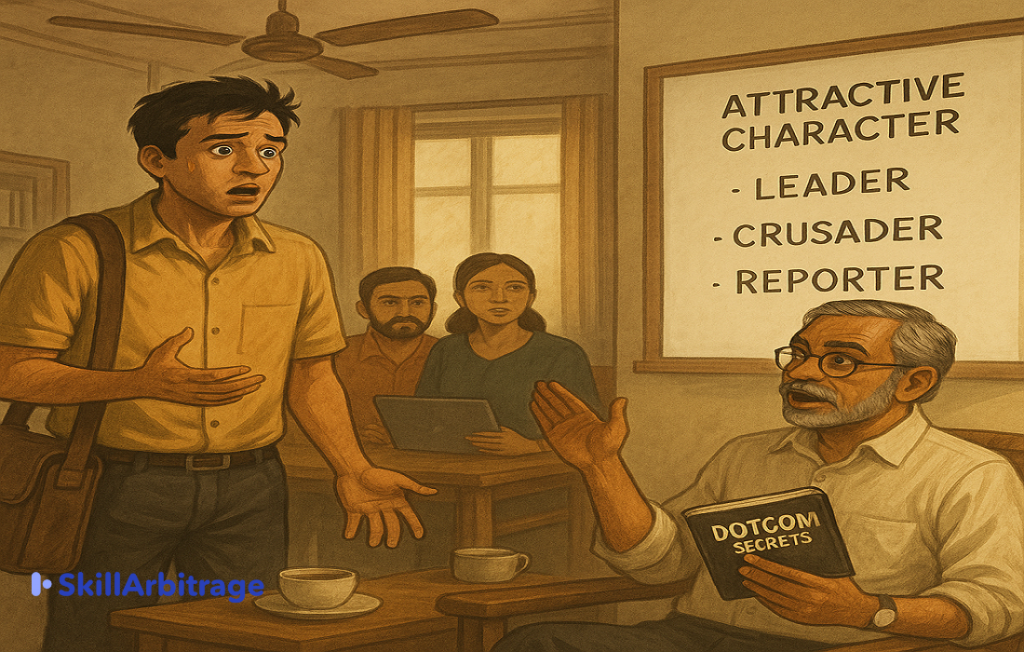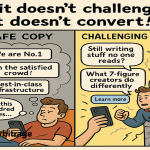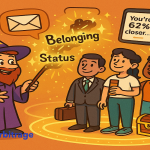This article is for freelancers, founders, and creators who want to be seen, remembered, and bought from. You will learn a storytelling framework adapted from Russell Brunson’s DotCom Secrets used by top marketers to build trust, grab attention, and drive sales. By the end, you will know how to turn your backstory into a brand asset that sells without faking it.
Table of Contents
Previously on Value Ladder…
Raghunandan showed Raja, Savitha, and Harsh how to escape the one-off project trap using the Value Ladder, by designing service tiers that turn scattered gigs into steady, strategic client relationships.
Now, it’s not enough to sell the ladder. You have to become the reason people climb it. In this article, Harsh will learn from Parvathishankar how to craft an Attractive Character using timeless storytelling principles so your audience sees you, trusts you, and buys from you without second-guessing.
(Continued…)
The fans hummed overhead, stirring the thick Chennai air. Raja sat cross-legged at one end of the table, tapping out bullet points for a landing page. Savitha was deep in a Notion board, her screen a color-coded battlefield of tasks. Across the room, Parvathishankar reclined in his old cane chair, reading the Hindu, his glasses halfway down his nose, his tea gone cold.
Then came the sound of feet pounding up the stairs, followed by the door flinging open.
Harsh stood there, flushed, sweaty, eyes wide like someone had just told him the RBI was banning email marketing.
“I’ve got a problem.”
He dropped his bag. It hit the floor with the thud of panic.
“I just landed a storytelling assignment. For a B2B brand. They want a full narrative funnel. It pays well. Like, actually well. But I have no clue how to do it.”
He stepped into the room like it might bite him.
“I know numbers. I know how to fix a leaky welcome sequence. I can write a 5-email reactivation flow in my sleep. But stories?” He made a noise halfway between a laugh and a snort. “It’s all wishy-washy fluff. Not serious. Not technical. Not me.”
He kept pacing.
“I don’t even know where to start. Everyone keeps saying, ‘tell a story that sells,’ but no one tells you what that means. Like what, a hero’s journey? Joseph Campbell? Frodo saves the funnel?”
Savitha shut her laptop calmly. Raja watched him with a mixture of curiosity and restraint.
Harsh didn’t stop.
“I feel like I’m being gaslit. I’ve spent years getting good at the hard stuff. The measurable stuff. And now I’m being told that if I can’t write like some myth-weaving bard, I don’t belong?”
Parvathishankar didn’t move for a moment. Then he folded his newspaper once, slowly, and placed it on the side table.
“You think stories are decoration,” he said, eyes still on the floor, voice so calm it cut straight through the room. “They’re not. They’re direction.”
Harsh stopped mid-step.
“Because stories are built on low-probability, high-salience events,” Parvathishankar continued, “they stick. They’re memory’s compression algorithm.”
He stood and walked to the shelf, pulling out a battered, underlined copy of Dotcom Secrets.
“You won’t remember that 0.01% of flights crash. But you’ll remember the one that landed in the Hudson. You won’t retain a lecture on ethics. But you’ll remember Breaking Bad.”
He placed the book on the table, tapping the cover.
“That’s why religions use parables. Why marketers tell origin stories. Why every culture passes knowledge through tales, not spreadsheets.”
He turned to Harsh fully now.
“Stories aren’t entertainment. They’re cognitive scaffolding. Because they defy probability, they stand out. And because they stand out, we remember them. Which is why, if you want to be remembered and bought from, you must become a storyteller. Not a technician.”
Harsh stood frozen. The panic hadn’t vanished. But it had a new shape now. He wasn’t just unprepared. He was unarmed.
“Sit down,” said Parvathishankar. “It’s time you learned the four traits people buy from. And the four stories that never fail.”
The Attractive Character framework by Russell Brunson
Parvathishankar tapped the cover of the book again.
“DotCom Secrets. Russell Brunson. Not just for funnel nerds. This is where the real game begins.”
Harsh frowned. “I thought that book was about upsells and webinar hacks.”
“It is. But hidden inside is something far more important. The part most people skip because they think it’s too soft, too personal. That’s the part that sells.”
He sat down again, fingers steepled.
“Before traffic. Before tactics. You have to become someone worth buying from. Someone your audience sees as more than a service provider. A character they trust. A voice they remember. A person they root for.”
Savitha nodded slowly, already sensing where this was going.
Parvathishankar continued, “Brunson calls it the Attractive Character. It’s the foundation behind every brand that doesn’t have to scream to be heard. It’s how you turn you into your most powerful asset.”
This is how you become someone your audience sees, trusts, and buys from.
Harsh sat down slowly, as if the chair might disappear beneath him.
Parvathishankar opened DotCom Secrets to a dog-eared chapter. He didn’t read from it. He just looked at Harsh.
“The Attractive Character has four traits,” he said. “Get these right, and you don’t just tell a story. You become one. Your audience won’t just buy from you. They’ll follow you.”
Harsh leaned forward. Listening now like his career depended on it.
1. Backstory
“Start with your backstory,” said Parvathishankar. “No story, no connection. It’s not decoration. It’s the emotional bridge between you and your reader.”
He looked at Raja.
“What’s the one thing clients always ask you?”
“Have you done this before?” said Raja.
“Exactly. But what they’re really asking is, Have you felt what I’m feeling?”
Then to Harsh:
“That’s what your backstory must do. Be relatable. Be flawed. Be human. Don’t give them stats. Give them stakes. Show them the pain you solved for yourself and now solve for others.”
Harsh frowned. “But what if you don’t have a story like that?”
“Then borrow one,” said Parvathishankar. “From a student. From a client. Jared didn’t become famous because he ate Subway. He became famous because he used it to drop from 425 to 190 pounds. That’s not trivia. That’s transformation.”
2. Parables
“Next,” said Parvathishankar, flipping a page and scribbling something in the margin. “Parables.”
He held it up:
The grapes are sour.
Raja chuckled. “I still remember that one.”
“Exactly,” said Parvathishankar. “We forget explanations. We remember parables. Teach through moments, not modules.”
He turned to Savitha.
“Tell them about the podcast that made you trust that skincare brand.”
She smiled. “The founder told a story about delivering her first order in an auto, getting drenched in the rain, and crying in front of the customer.”
Parvathishankar nodded.
“You remember that. Not the ingredients. Not the pricing. That.”
3. Character Flaws
“Third,” he said, turning back to Harsh. “Flaws.”
Harsh raised an eyebrow. “I thought we were supposed to look like we have it all figured out.”
“Perfection is a mask,” said Parvathishankar. “People trust what’s behind it.”
He stepped closer.
“If you never show weakness, you never build trust. Superman was boring until he bled. Your audience doesn’t want a superhero. They want a guide with scars.”
Harsh was quiet. Processing it.
4. Polarity
“And last,” said Parvathishankar, walking to the window. “Polarity.”
He turned, face calm but sharp.
“If you want loyalty, pick a side. If you want attention, risk offence.”
He folded his arms.
“No one shares a lukewarm take. They share the one that makes them nod or argue. Neutrality is safe. But it’s also invisible.”
Then, a long pause.
Harsh finally spoke.
“So basically… I have to stop being the polite guy who ‘knows his stuff’ and start being the flawed, loud, sticky one who feels something?”
Parvathishankar smiled.
“Now you’re getting it.”
3 Attractive Character identities
Harsh was still scribbling when Parvathishankar reached for his tea, took one sip, and grimaced.
“Cold again,” he muttered. “Never mind.”
He placed the cup down and continued.
“Now that you understand the traits,” he said, “you need to decide how to show up. That’s where your identity comes in. People don’t just follow what you say. They follow who they believe you are.”
He walked to the whiteboard and wrote three words in block letters.
Leader. Crusader. Reporter.
1. Leader
He tapped the first word.
“The Leader says, ‘I’ve walked the path. Let me show you.”
“Think of someone who’s solved the exact problem their audience is facing. They’ve already done the reps. Now they lead from the front.”
Raja nodded. “Like that guy who scaled his agency to 8 figures and now teaches other agencies.”
“Yes,” said Parvathishankar. “He’s not guessing. He’s guiding.”
Then, to Harsh:
“You’ve fixed over a hundred email sequences. You have results. You’ve led clients out of messes. You’re not an influencer. You’re a field medic.”
Harsh scribbled Leader = Show scars, not scripts.
2. Adventurer/Crusader
Parvathishankar underlined the second word.
“The Crusader is still in the mud. Still figuring it out. And that’s what makes people trust him.”
He looked at Savitha.
“You didn’t launch Tantra as an expert. You shared your struggles. The testing. The rejections. That made your story believable.”
She smiled. “I didn’t have answers. Just obsession.”
“Exactly,” he said. “That’s the Crusader. Driven, flawed, in motion. People follow her because they see themselves in her.”
Harsh looked up. “So it’s okay to be learning in public?”
“It’s not just okay,” said Parvathishankar. “It’s powerful. Honesty builds intimacy.”
3. Reporter/Evangelist
Finally, he tapped the third word.
“The Reporter says, ‘I don’t have the answers, but I talk to those who do.”
Harsh tilted his head. “Like podcast hosts?”
“Yes,” said Parvathishankar. “But also newsletter curators. Interviewers. Summarizers. People who make discovery useful.”
He leaned in.
“This identity is perfect if you’re early in your journey. You earn trust by shining light on others. You become valuable not by knowing but by noticing.”
Raja smiled. “Basically: learn out loud.”
“Exactly.”
Parvathishankar stepped back.
“These three are not costumes. They’re lenses. Choose the one that reflects your current truth. Then lean into it.”
Harsh looked at the whiteboard, the three identities staring back at him.
“I think I’ve been trying to be all three. At once. And badly.”
“You’re not alone,” said Parvathishankar. “But clarity is power. Pick the identity that fits your current path, not your future resume.”
Harsh circled Leader. Underlined it twice. Then paused.
“Wait,” he said, “what do I do with all this?”
Parvathishankar grinned. “You’re ready for the next part.”
4 Attractive Character storylines
Parvathishankar wiped the whiteboard clean. Then, with a red marker, drew a large “X” at the center.
“Alright,” he said. “You’ve picked your identity. But identity without stories is like a face without expression. No movement. No memory.”
He drew four arrows radiating from the X.
“These are your conversion stories. Not entertainment. Not filler. These are your greatest hits. Told again and again, across every offer, email, landing page, and pitch. Get these right, and you’ll never be boring again.”
1. Loss and Redemption
“I failed. I paid the price. I came back.”
He circled the top-left arrow.
“This is your comeback arc. Think debt, divorce, burnout, rejection. Your audience doesn’t want gods. They want survivors.”
Savitha raised an eyebrow. “Bit dramatic, isn’t it?”
Parvathishankar nodded. “Yes. That’s the point. Drama sticks.”
He turned to Harsh.
“You told me you almost quit freelancing after that SaaS retainer ghosted you.”
Harsh winced. “Yeah. Burned six months of savings.”
“That’s your loss,” said Parvathishankar. “Now pair it with the redemption. What shift brought you back?”
Harsh thought for a moment. “I rewrote my entire offer around lifetime value. Landed three clients in two weeks.”
“Perfect. That’s your story. Tell it often.”
2. Us vs. Them
“We’re the misfits. They’ll never understand us.”
Parvathishankar drew the next arrow.
“This one builds loyalty. You’re not just selling a solution. You’re declaring a side.”
He looked at Raja.
“You once said corporate marketers care more about awards than conversions.”
Raja shrugged. “They do.”
“There’s your line in the sand. You’re not just a strategist. You’re a rebel against vanity metrics. You make performance beautiful.”
He faced the room.
“When you draw a line, the right people cross over. The wrong people walk away. That’s good. Vanilla doesn’t convert.”
3. Before and After
“Look where I was. Look where I am now.”
“This one’s simple,” he said, drawing the third arrow. “But deadly effective.”
He pointed at Savitha. “Your DMs used to be tumbleweeds. Now you’re getting podcast invites.”
“Because I made my positioning louder,” she said.
“Exactly. Before: unclear founder. After: face of Tantra. That’s the story your customers buy.”
Harsh wrote:
Before: Obscure, Overworked, Insecure
After: Booked, Confident, Selective
“That’s your CTA,” said Parvathishankar. “You’re not selling services. You’re selling that shift.”
4. Amazing Discovery
“I found something no one else is talking about.”
Finally, he circled the last arrow.
“This is your scientist story. Your madman breakthrough. The ‘how the hell did you figure that out?’ moment.”
He faced Harsh again.
“You cracked a 67% open rate once, right?”
Harsh grinned. “Subject line plus first-line preview trick. Total fluke. But I’ve reused it ever since.”
“There’s your discovery. Give it a name. Turn it into a method. Teach it like a secret weapon.”
Parvathishankar stepped back.
“These four aren’t one-time stories. They’re narrative assets. Rotate them. Reuse them. Make them your brand’s core memory.”
He picked up his cup again.
“Still cold,” he sighed.
Harsh was already scribbling.
“Loss. Loyalty. Transformation. Breakthrough,” he muttered. “One per week. Story email series. Could work.”
Parvathishankar smiled.
“Now you’re thinking like a storyteller.”
Harsh sat back in the chair, quiet now. His hands weren’t fidgeting. His shoulders had dropped.
He picked up the pen beside him and scribbled something in his notebook. No funnel maps. No metrics. Just a sentence, half-mumbled.
“I used to think storytelling was fluff.”
He paused.
“But maybe it’s just strategy with a soul.”
Parvathishankar didn’t respond. He didn’t need to.
The room was still. The fan turned overhead. Somewhere in the street below, a dog barked.
Raja stood, stretched, and grinned.
“Come on,” he said. “Let’s build your character arc.”
Savitha flipped open her laptop again.
Harsh smiled. Small, reluctant, but real.
Maybe he wasn’t a storyteller yet.
But he’d just found his opening line.
(To be continued…)







 Allow notifications
Allow notifications
